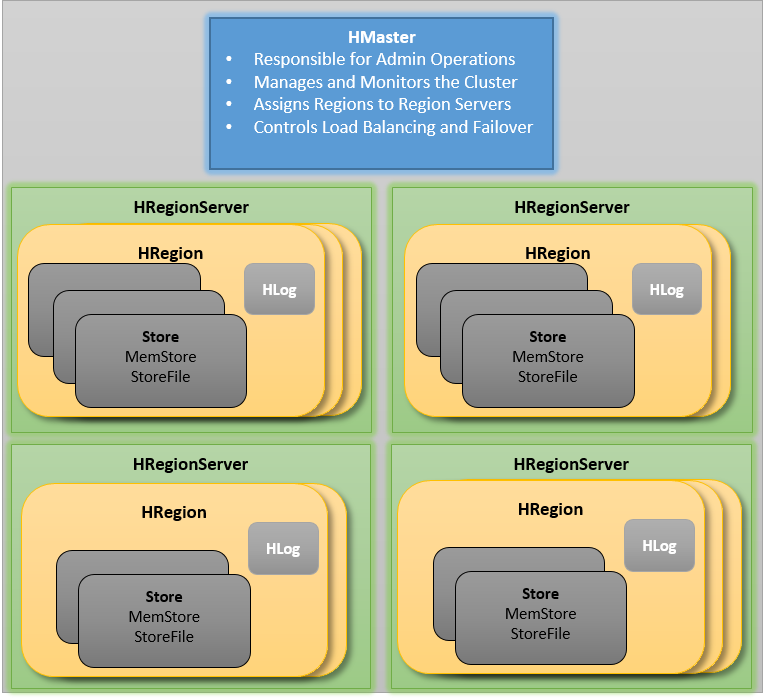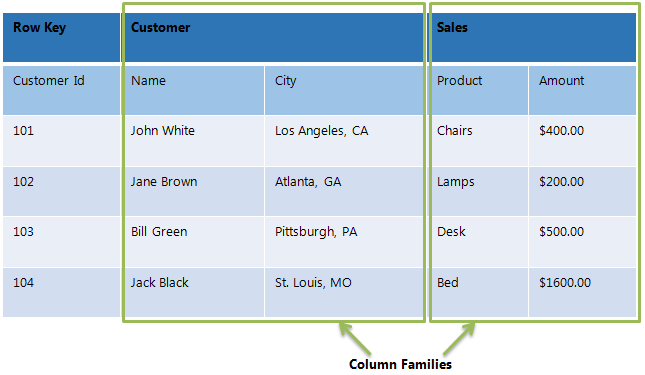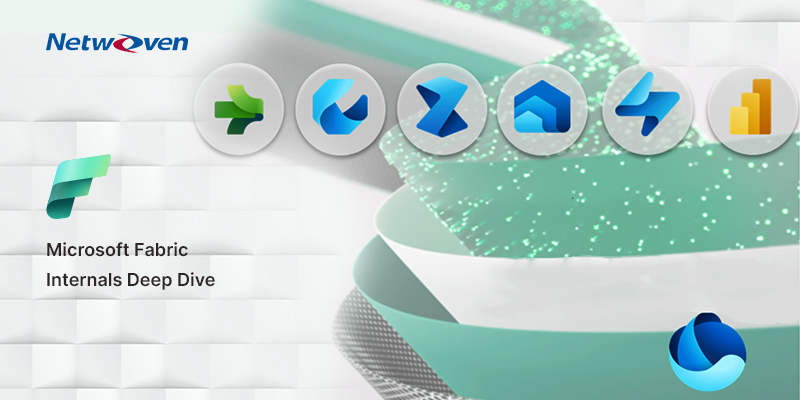In this article, we will briefly look at the capabilities of HBase, compare it against technologies that we are already familiar with and look at the underlying architecture. In the upcoming parts, we will explore the core data model and features that enable it to store and manage semi-structured data.
Introduction
HBase is a column-oriented database that’s an open-source implementation of Google’s Big Table storage architecture. It can manage structured and semi-structured data and has some built-in features such as scalability, versioning, compression and garbage collection.
Since its uses write-ahead logging and distributed configuration, it can provide fault-tolerance and quick recovery from individual server failures. HBase built on top of Hadoop / HDFS and the data stored in HBase can be manipulated using Hadoop’s MapReduce capabilities.
Let’s now take a look at how HBase (a column-oriented database) is different from some other data structures and concepts that we are familiar with Row-Oriented vs. Column-Oriented data stores. As shown below, in a row-oriented data store, a row is a unit of data that is read or written together. In a column-oriented data store, the data in a column is stored together and hence quickly retrieved.

Row-oriented data stores –
- Data is stored and retrieved one row at a time and hence could read unnecessary data if only some of the data in a row is required.
- Easy to read and write records
- Well suited for OLTP systems
- Not efficient in performing operations applicable to the entire dataset and hence aggregation is an expensive operation
- Typical compression mechanisms provide less effective results than those on column-oriented data stores
Column-oriented data stores –
- Data is stored and retrieved in columns and hence can read only relevant data if only some data is required
- Read and Write are typically slower operations
- Well suited for OLAP systems
- Can efficiently perform operations applicable to the entire dataset and hence enables aggregation over many rows and columns
- Permits high compression rates due to few distinct values in columns
Introduction Relational Databases vs. HBase
When talking of data stores, we first think of Relational Databases with structured data storage and a sophisticated query engine. However, a Relational Database incurs a big penalty to improve performance as the data size increases. HBase, on the other hand, is designed from the ground up to provide scalability and partitioning to enable efficient data structure serialization, storage and retrieval. Broadly, the differences between a Relational Database and HBase are:
Relational Database –
- Is Based on a Fixed Schema
- Is a Row-oriented datastore
- Is designed to store Normalized Data
- Contains thin tables
- Has no built-in support for partitioning.
HBase –
- Is Schema-less
- Is a Column-oriented datastore
- Is designed to store Denormalized Data
- Contains wide and sparsely populated tables
- Supports Automatic Partitioning
HDFS vs. HBase
HDFS is a distributed file system that is well suited for storing large files. It’s designed to support batch processing of data but doesn’t provide fast individual record lookups. HBase is built on top of HDFS and is designed to provide access to single rows of data in large tables. Overall, the differences between HDFS and HBase are
HDFS –
- Is suited for High Latency operations batch processing
- Data is primarily accessed through MapReduce
- Is designed for batch processing and hence doesn’t have a concept of random reads/writes
HBase –
- Is built for Low Latency operations
- Provides access to single rows from billions of records
- Data is accessed through shell commands, Client APIs in Java, REST, Avro or Thrift
HBase Architecture
The HBase Physical Architecture consists of servers in a Master-Slave relationship as shown below. Typically, the HBase cluster has one Master node, called HMaster and multiple Region Servers called HRegionServer. Each Region Server contains multiple Regions – HRegions.
Just like in a Relational Database, data in HBase is stored in Tables and these Tables are stored in Regions. When a Table becomes too big, the Table is partitioned into multiple Regions. These Regions are assigned to Region Servers across the cluster. Each Region Server hosts roughly the same number of Regions.

The HMaster in the HBase is responsible for
- Performing Administration
- Managing and Monitoring the Cluster
- Assigning Regions to the Region Servers
- Controlling the Load Balancing and Failover
On the other hand, the HRegionServer perform the following work
- Hosting and managing Regions
- Splitting the Regions automatically
- Handling the read/write requests
- Communicating with the Clients directly
Each Region Server contains a Write-Ahead Log (called HLog) and multiple Regions. Each Region in turn is made up of a MemStore and multiple StoreFiles (HFile). The data lives in these StoreFiles in the form of Column Families (explained below). The MemStore holds in-memory modifications to the Store (data).
The mapping of Regions to Region Server is kept in a system table called .META. When trying to read or write data from HBase, the clients read the required Region information from the .META table and directly communicate with the appropriate Region Server. Each Region is identified by the start key (inclusive) and the end key (exclusive)
HBase Data Model
The Data Model in HBase is designed to accommodate semi-structured data that could vary in field size, data type and columns. Additionally, the layout of the data model makes it easier to partition the data and distribute it across the cluster. The Data Model in HBase is made of different logical components such as Tables, Rows, Column Families, Columns, Cells and Versions.

Tables – The HBase Tables are more like logical collection of rows stored in separate partitions called Regions. As shown above, every Region is then served by exactly one Region Server. The figure above shows a representation of a Table.
Rows – A row is one instance of data in a table and is identified by a rowkey. Rowkeys are unique in a Table and are always treated as a byte[].
Column Families – Data in a row are grouped together as Column Families. Each Column Family has one more Columns and these Columns in a family are stored together in a low level storage file known as HFile. Column Families form the basic unit of physical storage to which certain HBase features like compression are applied. Hence it’s important that proper care be taken when designing Column Families in table.
The table above shows Customer and Sales Column Families. The Customer Column Family is made up 2 columns – Name and City, whereas the Sales Column Families is made up to 2 columns – Product and Amount.
Columns – A Column Family is made of one or more columns. A Column is identified by a Column Qualifier that consists of the Column Family name concatenated with the Column name using a colon – example: columnfamily:columnname. There can be multiple Columns within a Column Family and Rows within a table can have varied number of Columns.
Cell – A Cell stores data and is essentially a unique combination of rowkey, Column Family and the Column (Column Qualifier). The data stored in a Cell is called its value and the data type is always treated as byte[].
Version – The data stored in a cell is versioned and versions of data are identified by the timestamp. The number of versions of data retained in a column family is configurable and this value by default is 3.
Conclusion
In this article we looked at the major differences between HBase and other commonly used relational data stores and concepts. We also reviewed the HBase Physical Architecture and Logical Data Model. In the next article, we will cover the different ways in which clients can communicate with HBase and some of the other features that make HBase unique and well-suited for distributed data processing. Look forward to your questions and comments!


























It is in very understandable way, but as you mentioned, data will store in HFile. How it will move data from HFile to HDFS, because HBase will run top of HDFS. Could you please explain it. Thanks, Brahma —
Neatly explained. Very useful. Best article to begin learning HBase. Thanks.
The Best Topic For Basic Understanding of Hbase